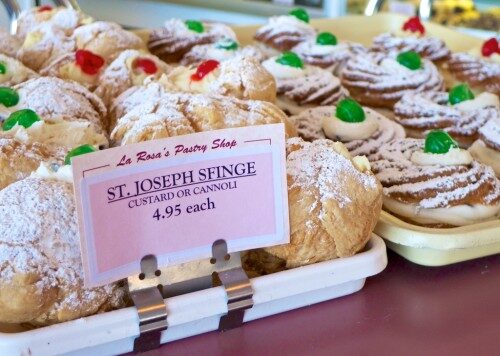
By JIM WILLIS
Monday’s St. Patrick’s Day celebrations may have been mostly about the beer and a bit about the corned beef, but Wednesday is St. Joseph’s Day, and that is all about the food. More specifically, it’s about the pastries: the sfinge and the zeppoli.
PieHole checked it with Peter LaRosa, who along with his brother, Sal, owns LaRosa’s Pastry Shop in Shrewsbury. LaRosa explained the difference between the sfinge and the zeppoli – each of which goes by more than one spelling, depending on dialect – and filled our ears with the history and tradition of St. Joseph’s Day like a pair of cannoli.
“Joseph was the father of Jesus, and the tradition is that if you have someone named Joseph or Josephine in your family, you buy [pastries] for them,” LaRosa says. “They can’t buy them for themselves. In the tradition, Jesus serves Joseph. It’s all about taking care of Joseph.”
And, as LaRosa tells it, you don’t bring Joseph/Josephhine just one zeppoli: you bring a dozen or two. At least that’s the way it used to be up until the 1970s or so, according to LaRosa.
“People used to buy them by the dozens. The old-timers, they’ll still buy six or maybe a dozen. Nowadays though, people buy two or three.”
LaRosa says that as Italians moved out of New York, traditions started to fall by the wayside.
“Out here [in the suburbs], you have a bigger mix of people, and not everyone keeps up with tradition. Part of what we do here is try to keep that alive.”
One way LaRosa keeps the customs alive is by offering the sfinge and zeppoli only from about two weeks before St. Joseph’s Day until Easter, which this year falls on April 20.
“After that, that’s it,” he says. “You have to wait until next year. People will ask for them throughout the year, but we don’t make them because then it’s not special anymore. It’s special to have them just for St. Joseph’s to keep the tradition.”
As for the difference between the sfinge ($4.95 each) and the zeppoli ($3.95 each), LaRosa says the dough is the same, but the sfinge is the original pastry that you would have found on the traditional St. Joseph’s feast table in Sicily – albeit made with lard instead of shortening.
The sfinge is a larger pastry, filled with cannoli filling — typically ricotta cheese with powdered sugar. LaRosa tells PieHole that the sfinge is what his great, great grandfather was making back in the 1850s though it probably would have been a goat’s milk cheese in the filling.
LaRosa tells us that the zeppoli started gaining popularity in the 1940’s because it was easier to make and faster to fry.
“Back [in the ’40s], the zeppoli was the new thing, and they would be filled with custard instead of cannoli filling.”
Now, LaRosa makes both sfinges and zeppolis, and offers them filled with either custard or cannoli filling.
“The old-fashioned Italians, though, they don’t want the zeppoli, they want the sfinge,” he says. “They’ll be here tomorrow asking for them.”





















